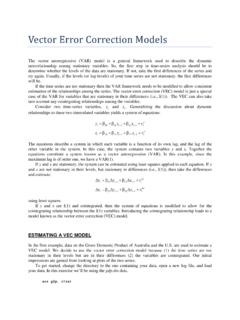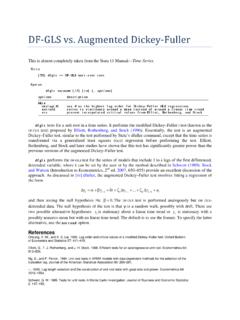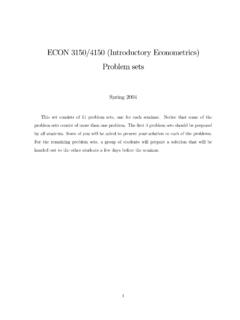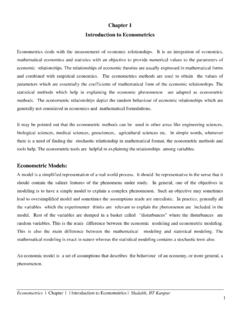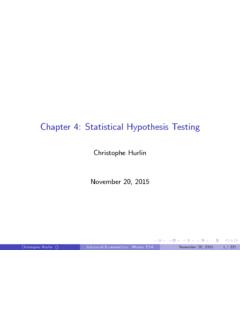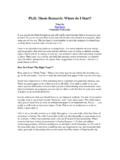Transcription of Introducing Stata - LearnEconometrics.com
1 1 Introducing Stata STARTING Stata Stata can be started several ways. First, there may be shortcut on the desktop that you can double-click. For the Stata /SE Release 10 it will look like Earlier versions of Stata have a similar looking Icon, but of course with a different number. Alternatively, using the Windows menu, click the Start > All Programs > Stata 10. A second way is to simply locate a Stata data file, with *.dta extension, and double-click. THE OPENING DISPLAY Once Stata is started a display will appear that contains windows titled Command this is where Stata command are typed Results output from commands, and error messages, appear here Review a listing of commands recently executed Variables names of variables in data and labels (if created) It should look something like 2 Chapter 1 Across the top are Stata pull-down menus.
2 We will explore the use of many of these. In the lower left-hand corner is the current path to a working directory where Stata saves graphs, data files, etc. We will change this in a moment. EXITING Stata To end a Stata session click on File Select Exit We will denote sequential clicking commands like this as File > Exit. Alternatively, simply type Introducing Stata 3 exit in the Command window and press Enter. Stata DATA FILES FOR STOCK AND WATSON Stata data files have the extension *.dta. These files should not be opened with any program but Stata . If you locate a *.dta file using double-click it will also start Stata . You can obtain the data files from Stock and Watson s web site (follow the link on my homepage).
3 The can also be found at: A working directory You should copy the data into a convenient directory. How to accomplish this will depend on your computer system. In this Windows-based book we will use the subdirectory c:\data\ Stata for all our data and result files. To change the working directory to this location type cd c:\data\ Stata into the Command window and press Enter. The result of this command is 4 Chapter 1 Note that in the Results window the command is echoed, and it appears in the Review window as well. The new path is indicated at the bottom left of the screen. If you are working in a computer laboratory, you may want to have a storage device such as a flash or travel drive.
4 These are large enough to hold the Stata data files, definition files and your class work. Make a subdirectory on the device. Calling it X:\DATA where X:\ is the path to your device, would be convenient. OPENING Stata DATA FILES There are several ways to open, or load, Stata data files. We will explain a couple of them. The use command With Stata started, change your working directory to the where you have stored the Stata data files. On the Command window type use caschool and press Enter. Introducing Stata 5 This feature will prevent you from losing changes to a data file you may wish to save. If this happens, you can either save the previous data file [more on this below], or enter clear in the Command window.
5 The clear command will clear what is in Stata s memory. If you want to open the data file and clear memory, enter use caschool, clear Using the toolbar To open a Stata data file click the Open (use) icon on the toolbar Locate the file you wish to open, select it, and click Open. In the Review window the implied command is shown. use caschool Using files on the internet Stata offers a nice option if you are connected to the internet. Files can be loaded from a web site. The Stata data files are stored at For example, to load caschool, after saving previous data and/or clearing memory, enter in the Command window use Once the data are loaded onto your machine, you can save it using File > Save as and filling in the resulting dialog box.
6 6 Chapter 1 THE VARIABLES WINDOW In the Variables window the data file variables are listed Also shown are variable Labels, if they are present, along with the Type of variable and its Format. We will only display the variable Name and Label in future screen shots. Labels are useful and can be easily added, changed or deleted. On the Stata pull-down menu select Data > Labels > Label Variable. That is, In the resulting dialog box, you can alter the existing label by choosing Attach a label to a variable, choosing the variable from the Variable: drop-down list and typing in the New variable label. Click OK. Introducing Stata 7 Instead of the dialog box approach, type the following line in the Command window and press Enter label variable str "Student to teacher ratio" This command will create the label, and it will write over an already existing label for str.
7 In the dialog box you can also choose to Remove a label. DESCRIBING DATA AND OBTAINING SUMMARY STATISTICS There are a few things you should do each time a data file is opened, or when you begin a new problem. First, enter into the Command window describe This produces a summary of the variables in the data file, information about them, and their labels. 8 Chapter 1 Next, in the Command window, type summarize and press Enter. In the Results window we find the summary statistics Introducing Stata 9 Should you forget a Stata command, the pull-down menus virtually assure that with enough clicking you can obtain the desired result. To illustrate, click on Statistics on the Stata menu list You will find a long list of possible statistical analyses, some of which we will use.
8 For now select Summaries, tables, and tests Select Summary and descriptive statistics and then Summary statistics A dialog box will open that shows many options. For the basic summary statistics table no options are required. Stata automatically will provide the summary statistics for all the variables in the data set. You can select individual variables by typing their names in the Variables box. The Standard display will produce the number of observations, the arithmetic mean, the standard deviation, minimum and maximum of the data values 10 Chapter 1 THE Stata HELP SYSTEM The Stata help system is one if its most powerful features. Click on Help on the menu. Select Contents. Introducing Stata 11 Each of the blue words is linked to further screens.
9 You should explore these to get a feel for what is available. Using keyword search Now click on Help > Search In the Dialog box that opens there are several search options. To search all the Stata documentation and Frequently Asked Questions (FAQs) simply type in phrase describing what you want to find. It does not have to be a specific Stata command. For example, let s search for Summary Statistics. Up comes a list of topics that might be of interest. Once again blue terms are links. Click on Summarize. The resulting Viewer box shows the command syntax, which can be used when typing commands in the Command window, and many options. 12 Chapter 1 Using command search If you know the name of the Stata command you want help with, click Help > Stata Command In the resulting dialog box type in the name of the command and click OK.
10 Alternatively, on the command line type help summarize and press Enter Opening a dialog box If you know the name of the command you want, but do not recall details and options, a dialog box can be opened from the Command window. For example, if you wish to summarize the data using the dialog box, enter db summarize Introducing Stata 13 Or, enter help summarize, and click on the blue link to the dialog box. Stata COMMAND SYNTAX Stata commands have a common syntax. The name of the command, such as summarize is first. command [varlist] [if] [in] [weight] [, options] The terms in brackets [ ] are various optional command components that could be used. [varlist] is the list of variables for which the command is used.




